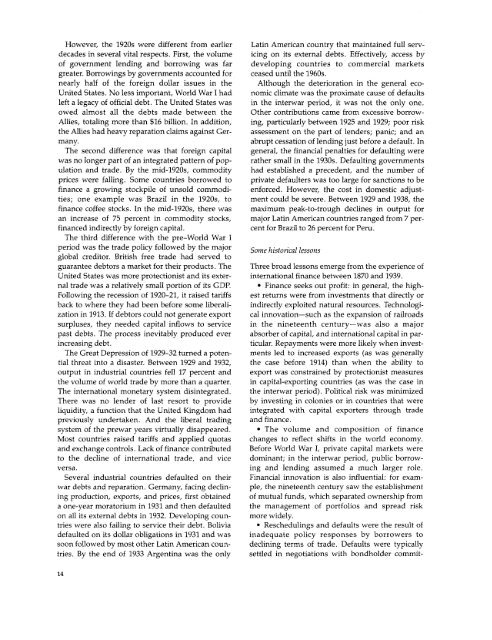World Bank Document
World Bank Document
World Bank Document
You also want an ePaper? Increase the reach of your titles
YUMPU automatically turns print PDFs into web optimized ePapers that Google loves.
However, the 1920s were different from earlier Latin American country that maintained full servdecades<br />
in several vital respects. First, the volume icing on its external debts. Effectively, access by<br />
of government lending and borrowing was far developing countries to commercial markets<br />
greater. Borrowings by governments accounted for ceased until the 1960s.<br />
nearly half of the foreign dollar issues in the Although the deterioration in the general eco-<br />
United States. No less important, <strong>World</strong> War I had nomic climate was the proximate cause of defaults<br />
left a legacy of official debt. The United States was in the interwar period, it was not the only one.<br />
owed almost all the debts made between the Other contributions came from excessive borrow-<br />
Allies, totaling more than $16 billion. In addition, ing, particularly between 1925 and 1929; poor risk<br />
the Allies had heavy reparation claims against Ger- assessment on the part of lenders; panic; and an<br />
many.<br />
abrupt cessation of lending just before a default. In<br />
The second difference was that foreign capital general, the financial penalties for defaulting were<br />
was no longer part of an integrated pattern of pop- rather small in the 1930s. Defaulting governments<br />
ulation and trade. By the mid-1920s, commodity had established a precedent, and the number of<br />
prices were falling. Some countries borrowed to private defaulters was too large for sanctions to be<br />
finance a growing stockpile of unsold commodi- enforced. However, the cost in domestic adjustties;<br />
one example was Brazil in the 1920s, to ment could be severe. Between 1929 and 1938, the<br />
finance coffee stocks. In the mid-1920s, there was maximum peak-to-trough declines in output for<br />
an increase of 75 percent in commodity stocks, major Latin American countries ranged from 7 perfinanced<br />
indirectly by foreign capital.<br />
cent for Brazil to 26 percent for Peru.<br />
The third difference with the pre-<strong>World</strong> War I<br />
period was the trade policy followed by the major Some historical lessons<br />
global creditor. British free trade had served to<br />
guarantee debtors a market for their products. The Three broad lessons emerge from the experience of<br />
United States was more protectionist and its exter- international finance between 1870 and 1939.<br />
nal trade was a relatively small portion of its G:DP. * Finance seeks out profit: in general, the high-<br />
Following the recession of 1920-21, it raised tariffs est returns were from investments that directly or<br />
back to where they had been before some liberali- indirectly exploited natural resources. Technologization<br />
in 1913. If debtors could not generate export cal innovation-such as the expansion of railroads<br />
surpluses, they needed capital inflows to service in the nineteenth century-was also a major<br />
past debts. The process inevitably produced ever absorber of capital, and international capital in parincreasing<br />
debt.<br />
ticular. Repayments were more likely when invest-<br />
The Great Depression of 1929-32 turned a poten- ments led to increased exports (as was generally<br />
tial threat into a disaster. Between 1929 and 1932, the case before 1914) than when the ability to<br />
output in industrial countries fell 17 percent and export was constrained by protectionist measures<br />
the volume of world trade by more than a quarter. in capital-exporting countries (as was the case in<br />
The international monetary system disintegrated. the interwar period). Political risk was minimized<br />
There was no lender of last resort to provide by investing in colonies or in countries that were<br />
liquidity, a function that the United Kingdom had integrated with capital exporters through trade<br />
previously undertaken. And the liberal trading and finance.<br />
system of the prewar years virtually disappeared. * The volume and composition of finance<br />
Most countries raised tariffs and applied quotas changes to reflect shifts in the world economy.<br />
and exchange controls. Lack of finance contributed Before <strong>World</strong> War I, private capital markets were<br />
to the decline of international trade, and vice dominant; in the interwar period, public borrowversa.<br />
ing and lending assumed a much larger role.<br />
Several industrial countries defaulted on their Financial innovation is also influential: for examwar<br />
debts and reparation. Germany, facing declin- ple, the nineteenth century saw the establishment<br />
ing production, exports, and prices, first obtained of mutual funds, which separated ownership from<br />
a one-year moratorium in 1931 and then defaulted the management of portfolios and spread risk<br />
on all its external debts in 1932. Developing coun- more widely.<br />
tries were also failing to service their debt. Bolivia * Reschedulings and defaults were the result of<br />
defaulted on its dollar obligations in 1931 and was inadequate policy responses by borrowers to<br />
soon followed by most other Latin American coun- declining terms of trade. Defaults were typically<br />
tries. By the end of 1933 Argentina was the only settled in negotiations with bondholder commit-<br />
14

















